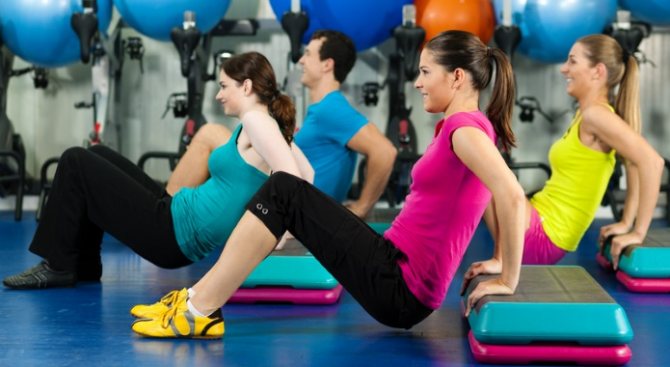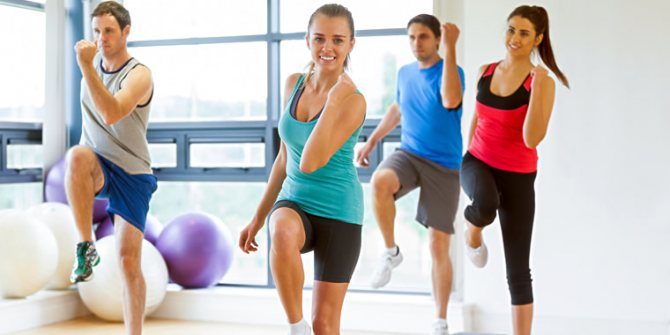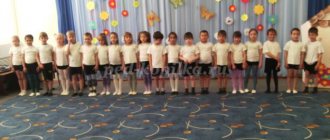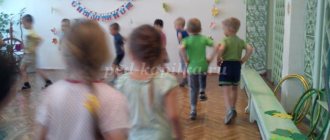Recommendations
Here are some of them:
- Any rhythmic gymnastics session should be done on an empty stomach or an hour and a half after eating.
- Training clothes should be as comfortable as possible so as not to restrict movement.
- Music for rhythmic gymnastics is of great importance. She should set the pace of the lesson and create a good mood. Therefore, it is necessary to carefully consider this “component” and select the most convenient rhythm for yourself, which will not cause overstrain of the body. As a rule, music is recorded separately for each block of exercises, then everything is edited. And the accompaniment goes without pauses, in one stream.
- When performing exercises, it is very important to alternate static and dynamic elements. It is recommended to focus on the weaker parts of the body.
- Over time, the load should be increased, continuing to alternate between fast and slow paces.
- It is recommended to consult a doctor before engaging in aerobic exercise. Injuries, respiratory diseases, pain syndromes, previous surgeries and high blood pressure are not a complete list of contraindications.
Positive Impact
Rhythmic gymnastics exercises have a beneficial, strengthening effect on the human body. They increase its protective functions against viral diseases and develop the skeletal and muscular systems. In the process of aerobic exercise, a person becomes more resilient, his blood circulation is activated, the body is intensively saturated with oxygen and vital energy increases. In addition, rhythmic gymnastics is a great way to cope with a bad mood, get rid of stress and lose extra pounds.
Reviews
Reviews of rhythmic gymnastics say that regular practice really lifts your mood and improves your overall tone. This is especially true for people who work in offices and drivers. They are forced to spend most of the day sitting.
Rhythmic gymnastics for children is useful and necessary. In this case, it does not increase activity, but corrects it. The muscular skeleton develops harmoniously. And training agility and plasticity minimizes the possibility of injury.
Peculiarities
All forms of this gymnastics have their own characteristics. For example, simple exercises are selected for morning exercises: step in place, jumps, half-squats and half-bends, short combinations of 4-5 elements (or movements). Morning rhythmic exercises are performed to medium-tempo music for a pleasant, relaxed performance.
Independent lessons are considered the most effective for the development and strengthening of the body. Rhythmic gymnastics (aerobics) includes three stages: warm-up, main and final parts. The first stage involves preparing (or warming up) the body. The duration of this part of the lesson is no more than 5 minutes. At the main stage, various muscle groups are worked on. Its duration is variable, depending on the tasks assigned. And finally, the final part is aimed at relaxing, stretching and restoring even breathing. It lasts approximately 5 minutes.

A little history
Historically, rhythmic gymnastics has its roots in Ancient Greece. It was then that disparate elements began to be combined into complexes and practiced with music. The purpose of all this was to develop a beautiful gait, posture, dexterity and plasticity of movements.
In the 19th century, the French psychiatrist Tsinal suggested that dance classes could cure people of certain diseases. And teacher F. Delsarte developed a complex of “expressive gymnastics” for creating mass performances. It included facial expressions, gestures, walking, and postures.
Rhythmic gymnastics came to Russia only at the beginning of the 20th century. Then the Institute of Rhythm was opened, where they trained teachers for music classes and colleges. This trend gained the greatest popularity only in the 80s, when various sets of exercises began to be developed, videotapes and show programs were produced, health clubs were created, etc.

Final part
The important task here is to gradually reduce speed and load. For this stage of the lesson, waves (from right to left and from bottom to top), lunges to the side with simultaneous rotation of the arms in the elbow joints, and circular movements of the shoulders are suitable.
Also place your feet apart and keep your hands on your knees. As you inhale, round your back, and as you exhale, bend your back.
Finally, stand up straight. Raise your arms up to your sides, while taking a deep breath. Then slowly lower down – exhale. Repeat 4 times.




